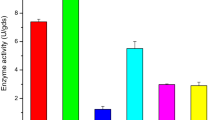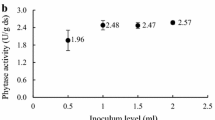Abstract
Development of an ideal process for reduction of food phytates using microbial phytases is a demanding task by all food and feed industries all over the world. Phytase production by Bacillus subtilis subsp. subtilis JJBS250 isolated from soil sample was optimized in submerged fermentation using statistical tools. Among all the culture variables tested, sucrose, sodium phytate and Tween-80 were identified as the most significant variables using the Placket–Burman design. Further optimization of these variables resulted in a 6.79-fold improvement in phytase production (7170 U/L) as compared to unoptimized medium. Supplementation of microbial phytases (fungal and bacterial) resulted in improved bioavailability of nutritional components with the concomitant liberation of inorganic phosphorus, reducing sugar, soluble protein and amino acids, thus mitigating anti-nutritional properties of phytic acid.


Similar content being viewed by others
References
Vohra, A., & Satyanarayana, T. (2003). Phytases: microbial sources, production, purification and potential biotechnological applications. Critical Reviews in Biotechnology, 23, 29–60.
Vats, P., & Banerjee, U. C. (2004). Production studies and catalytic properties of phytases (myo-inositolhexakisphosphate phosphohydrolases): an overview. Enzyme and Microbial Technology, 35, 3–14.
Singh, B., & Satyanarayana, T. (2011). Phytases from themophilic molds: their production, characteristics and multifarious applications. Process Biochemistry, 46, 1391–1398.
Singh, B., Kunze, G., & Satyanarayana, T. (2011). Developments in biochemical aspects and biotechnological applications of microbial phytases. Biotechnology and Molecular Biology Reviews, 6, 69–87.
Jinender, J., Sapna, & Singh, B. (2016). Characteristics and biotechnological applications of bacterial phytases. Process Biochemistry, 51, 159–169.
Singh, B., & Satyanarayana, T. (2015). Fungal phytases: characteristics and amelioration of nutritional quality and growth of non-ruminants. Journal of Animal Physiology and Animal Nutrition, 99, 646–660.
Vohra, A., & Satyanarayana, T. (2002). Statistical optimization of the medium components by response surface methodology to enhance phytase production by Pichia anomala. Process Biochemistry, 7, 999–1004.
Bogar, B., Szakacs, G., Pandey, A., Abdulhameed, S., Linden, J. C., & Tengerdy, R. P. (2003). Production of phytase by Mucor racemosus in solid-state fermentation. Biotechnology Progress, 19, 312–319.
Sonia, D., & Namita, S. R. (2009). Optimization of growth parameters of phytase producing fungus using RSM. Journal of Scientific and Industrial Research, 68, 955–959.
Singh, B., & Satyanarayana, T. (2006a). A marked enhancement in phytase production by a thermophilic mould Sporotrichum thermophile using statistical designs in a cost-effective cane molasses medium. Journal of Applied Microbiology, 101, 344–352.
Singh, B., & Satyanarayana, T. (2008a). Improved phytase production by a thermophilic mould Sporotrichum thermophile in submerged fermentation due to statistical optimization. Bioresource Technology, 99, 824–830.
Bajaj, B. K., & Wani, M. A. (2011). Enhanced phytase production from Nocardia sp. MB 36 using agro-residues as substrates: potential application for animal feed production. Engineering in Life Sciences, 6, 620–628.
Gangoliya, S. S., Gupta, R. K., & Singh, N. K. (2015). Phytase production through response surface methodology and molecular characterization of Aspergillus fumigatus NF191. Indian Journal of Experimental Biology, 53, 350–355.
Kumari, A., Satyanarayana, T., & Singh, B. (2015). Mixed substrate fermentation for enhanced phytase production by thermophilic mould Sporotrichum thermophile and its application in beneficiation of poultry feed. Applied Biochemistry and Biotechnology. doi:10.1007/s12010-015-1868-8.
Sapna, & Singh, B. (2015). Biocatalytic potential of protease-resistant phytase of Aspergillus oryzae SBS50 in ameliorating food nutrition. Biocatalysis and Biotransformation, 33, 167–174.
Fiske, C. H., & Subbarow, Y. P. (1925). The colorimetric determination of phosphorus. The Journal of Biological Chemistry, 66, 375–400.
Plackett, R. L., & Burman, J. P. (1946). The design of optimum multi-factor experiments. Biometrika, 33, 305–325.
Singh, B., & Satyanarayana, T. (2006b). Phytase production by thermophilic mold Sporotrichum thermophile in solid-state fermentation and its application in dephytinization of sesame oil cake. Applied Biochemistry and Biotechnology, 133, 239–250.
Mittal, A., Singh, G., Goyal, V., Yadav, A., & Aggarwal, N. K. (2011). Optimization of medium components for phytase production on orange peel flour by Klebsiella sp. DB3 using response surface methodology. Innovative Romanian Food Biotechnology, 9, 35–44.
Rani, R., Arora, S., Kumar, S., & Ghosh, S. (2013). Optimization of medium components for the production of phytase by R. oryzae using statistical approaches. Journal of Bioremediation & Biodegradation. doi:10.4172/2155-6199.S18-003.
Berikten, D., & Kivanc, M. (2014). Optimization of solid-state fermentation for phytase production by Thermomyces lanuginosus using response surface methodology. Preparative Biochemistry and Biotechnology, 44, 834–848.
Thyagarajan, R., Namasivayam, S. K. R., & Kumar, G. K. (2014). Optimization of medium components for phytase production by Hypocrea lixii SURT01 using response surface methodology. Journal of Pure and Applied Microbiology, 8, 2485–2490.
Tran, T. T., Mamo, G., Mattiasson, B., & Hatti-Kaul, R. (2010). A thermostable phytase from Bacillus sp. MD2: cloning, expression and high-level production in Escherichia coli. Journal of Industrial Microbiology and Biotechnology, 37, 279–287.
Rao, D. E. C. S., Rao, K. V., & Reddy, V. D. (2008). Cloning and expression of Bacillus phytase gene (phy) in Escherichia coli and recovery of active enzyme from the inclusion bodies. Journal of Applied Microbiology, 105, 1128–1137.
Guerrero-Olazaran, M., Rodriguez-Blanco, L., Carreon-Trevino, J. G., Gallegos-Lopez, J. A., & Viader-Salvado, J. M. (2010). Expression of a Bacillus phytase C gene in Pichia pastoris and properties of the recombinant enzyme. Applied and Environmental Microbiology, 76, 5601–5608.
Hmida-Sayari, A., Elgharbi, F., Farhat, A., Rekik, H., Blondeau, K., & Bejar, S. (2014). Overexpression and biochemical characterization of a thermostable phytase from Bacillus subtilis US417 in Pichia pastoris. Molecular Biotechnology, 56, 839–848.
Sanz-Penella, J. M., Frontela, C., Ros, G., Martinez, C., Monedero, V., & Haros, M. (2012). Application of bifidobacterial phytases in infant cereals: effect on phytate contents and mineral dialyzability. Journal of Agricultural and Food Chemistry, 60, 11787–11792.
Singh, B., & Satyanarayana, T. (2008b). Phytase production by a thermophilic mould Sporotrichum thermophile in solid state fermentation and its potential applications. Bioresource Technology, 99, 2824–2830.
Bala, A., Sapna, Jain, J., Kumari, A., & Singh, B. (2014). Production of an extracellular phytase from a thermophilic mould Humicola nigrescens in solid state fermentation and its application in dephytinization. Biocatalysis and Agricultural Biotechnology, 3, 259–264.
Sapna, & Singh, B. (2014). Phytase production by Aspergillus oryzae in solid-state fermentation and its applicability in dephytinization of wheat bran. Applied Biochemistry and Biotechnology, 173, 1885–1895.
Acknowledgments
Authors are highly thankful to the Department of Science and Technology (No. SR/FT/LS-95/2010), New Delhi, India for providing the financial assistance during this research work.
Author information
Authors and Affiliations
Corresponding author
Rights and permissions
About this article
Cite this article
Jain, J., Singh, B. Phytase Production and Development of an Ideal Dephytinization Process for Amelioration of Food Nutrition Using Microbial Phytases. Appl Biochem Biotechnol 181, 1485–1495 (2017). https://doi.org/10.1007/s12010-016-2297-z
Received:
Accepted:
Published:
Issue Date:
DOI: https://doi.org/10.1007/s12010-016-2297-z




